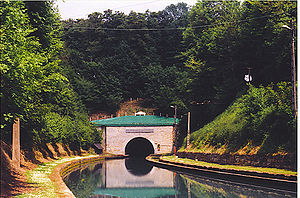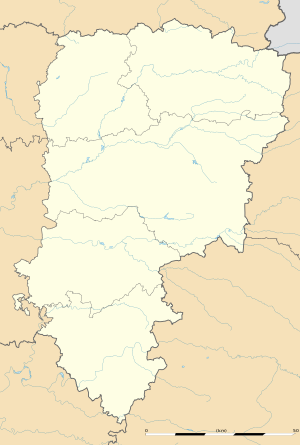Riquevaltunnel
| Riquevaltunnel | ||
|---|---|---|
|
South portal
|
||
| location | ||
|
|
||
| Coordinates | ||
| South portal | 49 ° 57 ′ 2 ″ N , 3 ° 14 ′ 9 ″ E | |
| North portal | 50 ° 0 ′ 6 ″ N , 3 ° 13 ′ 35 ″ E | |
The Riquevaltunnel (fr: Souterrain de Riqueval ) is one of two shipping tunnels on the Canal de Saint-Quentin in the French department of Aisne , north of the village of Bellenglise . The 5670 m long tunnel was built under the rule of Napoleon Bonaparte between 1801 and 1810 and is considered a technical masterpiece of its time. South of the village of Bellenglise is the Tronquoy tunnel (fr: Souterrain de Tronquoy ).
Development of shipping traffic in the tunnel
The 5,670 meter long Riqueval tunnel was built between 1801 and 1810 by order of Napoleon and is part of the Canal de Saint-Quentin, which connects Paris with northern France and Belgium . At first the boatmen pulled their boats through the tunnel themselves, which took about 20 hours. The width of the canal in the tunnel was 5.2 meters and was bordered on both sides by 1.4 meter wide paths. The width of the ships was limited to 4.4 meters at that time due to bottlenecks in other parts of the canal. Due to the increasing need for transport capacities for coal from Belgium, the tunnel, which can only be used in one direction, increasingly became the narrow point of the canal. Due to the long towing time, the tunnel could only be operated for two days in one direction and the two following days in the other direction.
From January 1840 a towage service was then used, with ten men per 20 tons available for each boat. This shortened the transit time to around seven to eight hours. But this advantage lasted only a short time. The loading capacity of the ships and thus their width and draft increased. When a ship is pulled, the water must be able to flow past the ship to the rear. However, since there was less space for this, the resistance increased when pulling at higher speed. The towing time increased again to around 18 hours.
First attempts with steam-powered chain tugs failed, as the smoke that was generated stayed in the tunnel for a long time due to the poor ventilation. The smoke also attacked the chalk layers of the mountain, which were not completely covered by masonry. Even the use of horses for towing did not bring the desired success. The resistance of the ships in the water was too high. Despite the optimization of the technique and the use of more horses, the towing time could be reduced to a maximum of 13 hours.
Jean-Baptiste Quaneaux developed a system of a horse-powered winch. This system had the advantage that the horses did not have to run along the narrow paths to the right and left of the canal. On a floating wooden pontoon there was a stage that protruded on both sides, on which up to eight horses drove a rotating cross in the middle like a carousel. This cross was connected to a large drum below the stage. A rope, which could be hooked to the tunnel wall every 200 meters, ran over the rotating drum below the stage and was then transferred to a smaller boat in front of the actual towing boat and rolled up there. Using the Quaneaux system made it possible to dispense with one of the two towpaths. By removing the path in 1861, the canal widened to 6.6 meters and the water resistance was drastically reduced.
From 1867, steam-powered chain vessels were used to transport ships on the 20.1 kilometer long, mostly single-aisle apex post. Within this section of the canal with the two tunnels, six state chain vessels were used, each with an output of 20 to 30 kW (25-40 hp ). Because of the heavy shipping traffic to Paris, very long and heavy tow trains had to be transported. The normal train consisted of 25 loaded ships, but 35 ships could also be pulled. The towing speed achieved with the attachment was only 0.9 to 1.1 kilometers per hour. The chain was initially 18 millimeters thick and gradually increased to 30 millimeters in the Riquevaltunnel. During the passage through the Riquevaltunnel, the water level was dammed up by 25 to 45 centimeters, and it took half an hour to an hour for this damming to dissipate again. During the long stay in the tunnel, people were exposed to heavy smoke pollution.
Since 1906, there has been an electrically powered chain shipping service at the tunnel for the ship's train . The chain ship uses a chain to move that is laid in the bottom of the canal and then runs across the deck of the ship. Here it is guided over rollers that are driven by an electric motor. In this way the tugboat reaches a speed of approx. 2.8 km / h. The passage through the tunnel takes about two hours. A three-pole overhead line for the power supply is attached to the ceiling of the tunnel, which continues for approx. 200 m at both ends of the tunnel. The chain ships are supplied with the required electrical energy via two pantographs .
The chain ship is 25 m long, five meters wide and has a draft of one meter. It can pull up to 32 peniches through the Riqueval tunnel. The chain laid in the canal is 8 kilometers long and weighs 96 tons. After a mechanical ventilation system was installed in the tunnel and the tunnel's utilization decreased, only one of the two chain tugs is still in operation. Even today, ships cannot pass through the tunnel directly, but are pulled through the tunnel with the tugboat.
The other chain tractor, named Ampère I, is located at the entrance of the tunnel and has been converted into the Museum of Chain Shipping (Musée du Touage).
Military use in the First World War
The tunnel undercuts the village of Bellicourt and the American Memorial Cemetery Bellicourt American Monument. The site was heavily contested in the battle of the Saint-Quentin Canal from September 29 to October 10, 1918. The German army used the tunnel as an arsenal and the canal for their Siegfried position .
Web links
- Basement de Riqueval. In: Structurae
- M. Lermoyez: Sur le touage des bateaux dans les souterrains du Canal de Saint-Quentin , In: Annales des ponts et chaussées, Tome VI, Paris 1863, pages 335-373 online
- MM PUGIN: L'histoire du Canal de Saint-Quentin In: Mémoires numérisés, Tome XXVII, 1982, pages 43-60, PDF , French
- Tow train at the tunnel entrance
Individual evidence
- ↑ a b c d e M. Lermoyez: Sur le touage des bateaux dans les souterrains du Canal de Saint-Quentin , In: Annales des ponts et chaussées, Tome VI, Paris 1863, pages 323-373 online
- ↑ Sur des chemins liquides: bateaux à propulsion animale (3). Finlande, France, Italie: tournez manèges from traitsensavoie.fr, accessed on May 13, 2019
- ^ Oskar Teubert: Die Binnenschiffahrt - A manual for everyone involved , Volume 2, Verlag Wilhelm Engelmann, Leipzig 1918, Part 4, Section III., Ship's train , 4. Dragging on a chain or rope, pages 268–287
- ↑ Le Touage de Riqueval. Archived from the original on March 4, 2008 ; Retrieved January 6, 2010 (French).
- ↑ Le toueur de Riqueval fête son centième anniversaire. Fluvial magazine, June 15, 2010, accessed October 31, 2010 (French).
- ↑ Bellicourt American Cemetery of Honor. American Battle Monuments Commission , accessed January 22, 2016 .
- ↑ Bellicourt British Cemetery of Honor ( Memento of the original from December 14, 2013 in the Internet Archive ) Info: The archive link was automatically inserted and has not yet been checked. Please check the original and archive link according to the instructions and then remove this notice.





